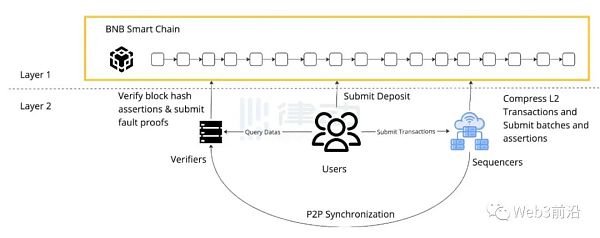Can OP Stack, the competitor launched by zkSync, win the L2 scaling battle?
Can OP Stack, zkSync's competitor, win the L2 scaling war?On the evening of June 26th, zkSync announced the launch of ZK Stack, a modular open source framework for building custom zkRollups. The aim is to give developers complete autonomy, from selecting data availability patterns to using their own project’s token for decentralized sequencer. ZK Stack provides two key functionalities: sovereignty and seamless connectivity. These zkRollup chains run independently, relying only on Ethereum L1 for their activity and security, while cross-chain bridges facilitate interconnectivity between each chain, achieving trustless, fast, and cheap interoperability.
The launch of ZK Stack inevitably brings to mind Optimism’s scalability solution, OP Stack. As a standardized set of open source modules, developers can assemble a custom chain via OP Stack to serve any specific blockchain use case. OP Stack’s design allows for code forking in an easier way than current efforts, as developers can easily abstract the various components of a blockchain and modify it by inserting different modules.
Announcing a product similar to Optimism and Arbitrum’s ecosystems before the mainnet token is even launched, ZK Stack is considered by many to be zkSync’s ace in the hole to compete with OP Stack and Arbitrum Orbit. What are the characteristics of ZK Stack? What are the pros and cons compared to OP Stack?
ZK Stack
Last week, the zkSync team shared the initial draft of ZK Credo, elaborating on the key attributes of a decentralized blockchain network and the necessity of ZK as the emerging foundation of the value internet. The launch of ZK Stack is based on the team’s expansionary vision.
- Introduction to ZK Stack by Matter-Labs – Building a modular framework for ZK-powered sovereign chains
- Application of liquidity in PoS: Examples of Berachain, Tenet, and Mangate
- Inventory of 11 Celebrity Cryptocurrency Scammers: Jake Blockingul, Floyd Mayweather, John Wall…
According to official documentation, ZK Stack is a free modular open source framework designed to build custom ZK-driven L2 and L3 based on zkSync Era code. The core of ZK Stack provides the two key functionalities of sovereignty and seamless connectivity, giving creators unrestricted autonomy to customize and shape every aspect of the chain. Overall, ZK Stack has three characteristics: open source, composability, and modularity.
ZK Stack is developed under the fully permissive MIT/ABlockingche open source license, ensuring its availability for free, and developers can contribute to and use it according to their needs. Secondly, the super chain built using ZK Stack can seamlessly connect in a trustless network, with low latency and shared liquidity. In addition, ZK Stack can help developers customize and shape their own Hyperchain, from choosing the sequencer and data availability pattern to defining their own token economy and more.
Paradigm Shift
For the zkSync core team, ZK Stack is also a significant paradigm shift. Prior to this, the team focused on building mature ZK technology and launched the EVM-compatible ZK Rollup – zkSync Era in early 2021. The launch of ZK Stack to some extent signifies a shift in the team’s work focus from technology to community. The team hopes that with the launch of more Hyperchains, the number of core contributors to the zkSync ecosystem will increase significantly and make the community the true owner of the zkSync ecosystem.
Similar to OP Stack, it will be a simpler process for developers to deploy a Hyperchain for their own applications and achieve asynchronous connections with other protocols in the ecosystem to perform various interoperability functions. In the ZK Stack documentation, the team lists several potential applications for Hyperchains:
1. When building a game or social network and need a lightweight sorter that is not burdened by other dApps and use cases;
2. When building a DeFi application chain that values low-latency sorting;
3. When an enterprise builds an internal private chain while also hoping to maintain interconnectivity with the Ethereum ecosystem;
Hyper-Scalability
In addition to its scalability characteristics, ZK Stack’s strong interoperability is also noteworthy. ZK Stack allows developers to build their own sovereignty chains without sacrificing interoperability and composability. Each Hyperchain can seamlessly integrate into the zkSync ecosystem, supported by shared provers and fractal extensions, to form a complete liquidity network.
With ZK Stack’s architecture, smart contracts on each Hyperchain will be able to call each other asynchronously across chains, and users can quickly transfer their assets in minutes in a trustless manner without incurring any additional costs. At the same time, the super-chain itself will have complete sovereignty and can join other ecosystems and take its own on-chain assets with it.
The ZK Stack team stated that in the next few weeks, they will modify the codebase to make it easier to check out, configure, and deploy instances of ZK Stack, with the ultimate goal of achieving one-click deployment, just like OP Stack.
OP Stack
Next, let’s take a look at the already released and widely adopted OP Stack. In October 2022, Ethereum Layer 2 scaling solution Optimism launched the modular open-source blueprint OP Stack, which the Optimism team sees as the next evolutionary stage of scalability architecture, suitable for various highly scalable and highly interoperable blockchains. OP Stack is a standardized open-source module that developers can use to assemble a blockchain that serves a specific use case. The design of OP Stack allows developers to fork Optimism’s code more easily, abstracting the various components of the blockchain and inserting different modules to modify Optimism’s code. For example, when an Optimistic Rollup wants to transform itself into a ZK Rollup, it only needs to replace its fraud proof module with a settlement layer validity proof module.
Open Garden
OP Stack first proposed the concept of “Open Garden”, which allows atomic cross-chain combination as long as OP chains voluntarily choose to enter the same shared sequencer set. If an OP chain does not want to run its own sequencer, it can pay a certain fee to use the Optimism shared sequencer that they trust, which also opens up a profit model for Optimism.
Based on this vision, Optimism refers to its OP chain as Superchain. The OP chain will be fully interoperable on Optimism and connected by the same technical structure. As the OP Stack shared module increases the flexibility of configuration, developers are repeating the recovery of reusable code previously used by developers, making the code stronger and more resistant to hackers and bugs.
Support from “Web3 Giants”
Shortly after OP Stack was launched, it received support from “Web3 giants”. In February of this year, Coinbase announced the launch of a multi-chain L2 platform built on OP Stack. This partnership aims to upgrade the Optimism mainnet, Base and other L2s to an initial superchain structure and share bridging and sequencing. As a blockchain of an OP platform, Base will return part of the transaction fee income to the Optimism Collective Treasury.
Base built on OP Stack has the security and scalability required to support decentralized applications, and uses the underlying security of Ethereum to allow users to enter Base from Coinbase, Ethereum L1 and other interoperable chains. At the same time, Base provides full EVM equivalence at extremely low cost and is committed to promoting the development of developer platforms. In addition, developers on Base can easily build decentralized applications by accessing Coinbase’s products, users, and tools, seamlessly integrating with Coinbase’s product suite, accessing $80 billion in assets, and providing services to platform users.
Which is better: Stack, OP, or Sync?
In addition to Coinbase, OP Stack, which has a first-mover advantage, has also been favored by “dragon-head public chains” such as BNB Chain. On June 19th, BNB Chain announced the launch of a new scaling solution, opBNB, and launched the opBNB testnet. With the surge in trading volume of GameFi and other projects, BSC often faces network congestion and high gas fees, and the existing design and architecture can no longer meet scalability needs. In this case, opBNB emerged, providing new possibilities for solving BSC’s scalability issues.
opBNB is a layer-two scaling solution built on top of BSC, which is also EVM-compatible and based on the OP Stack implementation of Bedrock. Similar to how Bedrock works, opBNB processes transactions off-chain and then publishes transaction data on-chain, compressing on-chain data to improve scalability.
Users interact with the opBNB network through applications or contracts, and Sequencers aggregate transactions, calculate state transitions, and submit them to the rollup contract on BSC. Provers generate cryptographic proofs to prove the validity of these state transitions, and Verifiers check these proofs to verify the correctness of the opBNB state.

Unlike Optimism and Coinbase’s layer-two solution Base, opBNB is built on top of BSC rather than Ethereum. BSC’s performance is superior to Ethereum, so opBNB’s performance is not only better than BSC’s, but also better than Optimism and other scaling solutions. According to official descriptions, opBNB has a block time of 1 second, transfer Gas fees as low as $0.005, and can handle more than 4000 transactions per second (TPS), which is better than existing scaling solutions.
In addition to public chains like BNB Chain, many application development teams have also chosen to develop their own application chains based on the OP Stack:
On March 1st, the game digital economy platform Cocos-BCX and NodeReal announced a global strategic cooperation to jointly develop the first Web3 game-centered Rollup Layer2 on BNB Chain based on Optimistic (OP) Stack. This cooperation will combine Cocos-BCX’s leading Web3 game scaling solution and NodeReal’s comprehensive blockchain infrastructure to support more than 1.6 million game developers in 2D/3D games, metaverse, artificial intelligence (AI) and extended reality (XR) development.
On April 20th, a16z Crypto announced the launch of a new Optimism Stack rollup client, Magi. Magi is an OP Stack rollup client developed in Rust that performs the same core functions as the reference implementation (OP-node) and works with execution nodes (such as OP-geth) to synchronize to any OP Stack chain, including Optimism and Base.
On June 22nd, NFT trading market Zora announced the launch of ZORA NETWORK, a Layer 2 network based on OP Stack. The network provides artists, creators, and communities with a faster and more efficient Ethereum extension, and directly integrates all existing zora tools. Zora Network has issued a second-layer NFT minting platform based on OP Stack, targeting NFT creators, brands, and collectors, providing a range of NFT creator tools, and reducing the cost of minting to below $3.
So has the OP Stack with first-mover advantage already won the L2 scalability battle over the ZK Stack?
After the release of the ZK Stack, the community compared the two in detail from a technical perspective. Blockchain researcher Haotian (@tmel0211) pointed out in a reply tweet that HyperChain does not need to maintain state and consensus and can directly rely on the security of Ethereum. Moreover, compared to the interactive fraud proof of the OP Rollup, HyperChain can use ZK proof to directly verify state changes between each other, without waiting for the underlying state change of Ethereum, so the efficiency of inter-chain interaction has also been greatly improved. In contrast, OP Stack still has limitations in asynchronous cross-chain calls. Its state changes need to wait for the underlying validation of Ethereum.
It can be seen that on one hand is the OP Stack with first-mover advantage, and on the other hand is the ZK Stack with technological advantages. The L2 scalability battle has just begun. Undoubtedly, no matter who wins in the end, the narrative of multi-chain expansion around Ethereum is gradually becoming an important driver of the new encryption cycle.
We will continue to update Blocking; if you have any questions or suggestions, please contact us!
Was this article helpful?
93 out of 132 found this helpful
Related articles
- Application of Liquidity in PoS: Examples from Berachain, Tenet, and Mangate
- Interpretation of How to Earn Profits with PENDLE
- Introducing two new NFTs launched this week: Ether and Azuki Elementals.
- The Ethereum team has tentatively scheduled the launch of a new testnet called Holešky on September 15th to replace Goerli.
- How does Curio integrate the ECS game engine into OP Stack?
- FTX’s new CEO: FTX has been lying to banks about its mixed funds issue
- Regulatory intervention creates a “bottom” for the market. How will Wall Street’s entry during the chaos affect the industry?




